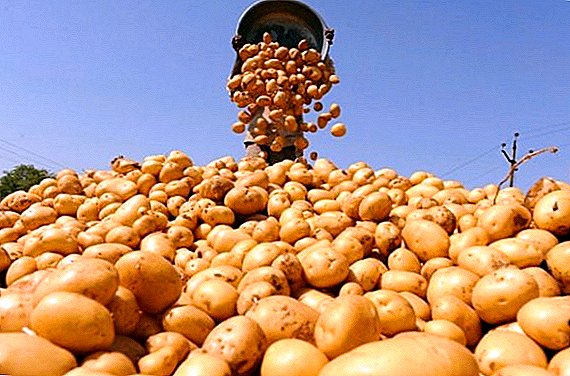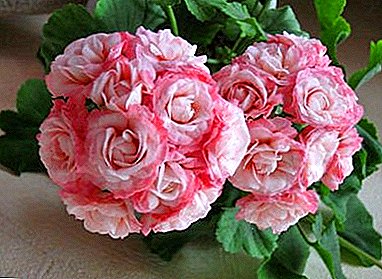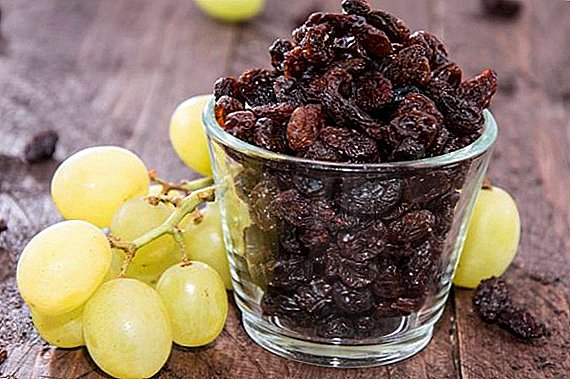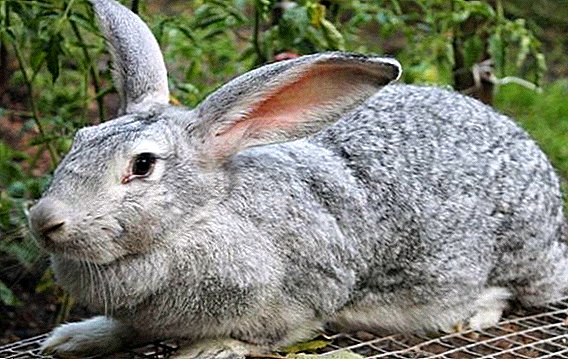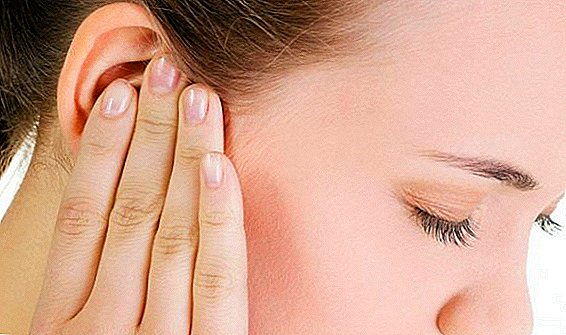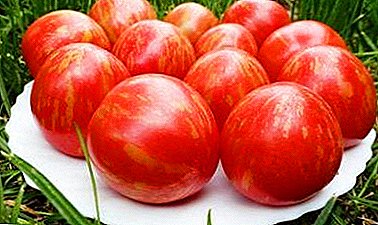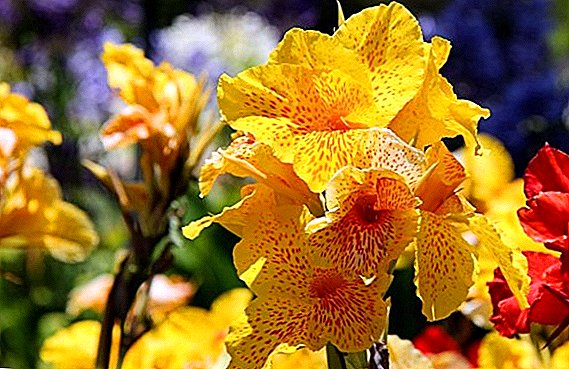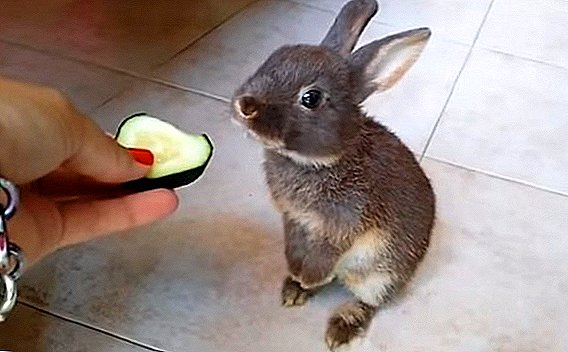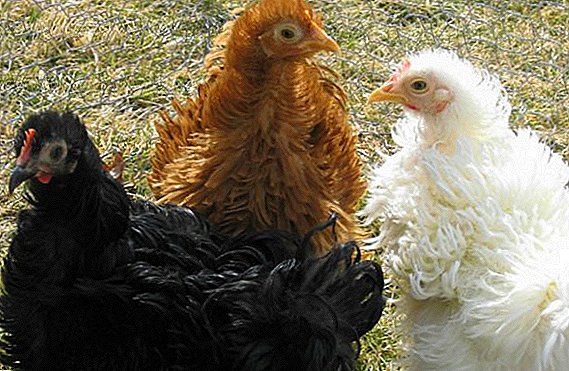 Many types of poultry do not differ decorative. The efforts of breeders are aimed at increasing productivity, and not at improving the appearance of chickens. At the same time, there is a breed that can surprise with both appearance and productivity.
Many types of poultry do not differ decorative. The efforts of breeders are aimed at increasing productivity, and not at improving the appearance of chickens. At the same time, there is a breed that can surprise with both appearance and productivity.
Consider curly chickens, their characteristics and requirements. Tell you about feeding and rearing.
History of origin
An ancient breed of chickens, which originates in Southeast Asia. It is not known for sure in which country the breed was born, but many sources indicate India.  After hatching chickens in Europe, they quickly gained popularity, after which they began to be bred in many farms, both for receiving products and as pets.
After hatching chickens in Europe, they quickly gained popularity, after which they began to be bred in many farms, both for receiving products and as pets.
External characteristics of chickens
Consider the appearance of the bird, as well as the characteristic differences. Tell about the gene curl.
Did you know? Chickens are emotional animals. They can empathize with others, as well as sad if they are lonely.
Coloring
By European standards let's say the next color: black, silver, white, fawn, blue. Some sources also mention brown as a valid color.
A defect is considered to be too dull or blurred color, as well as the presence of spots or stripes, which are different in color from the general color. 
Feathers
Home "highlight" breed - curled fluffy feathersthat both roosters and chickens have. For the presence of such a feather is the corresponding gene, which is inherited. If curly chickies mate with a breed that has standard plumage, then the young will have an average curl. When you next cross curliness will appear less and less. At the same time, the standard for this breed assumes that the individuals have an average curliness, which is achieved when the individuals with low and high curlyness are correctly crossed.
In this breed, the feather shaft has an arcuate shape; therefore, each feather is bent at a certain angle. The degree of curl affects not only the appearance, but also the fragility of the plumage, so much curly chickens have an unpresentable appearance, since their feathers fall out at the slightest touch.
Did you know? There is a breed of chickens that has a particular gene. This gene stains plumage, skin, internal organs and even bones black. Bred in Indonesia.
Torso
The head is of medium size, oval. The beak is slightly bent, of medium size, strong. The crest is small, short, shaped like a leaf or a rose. The iris of the eyes is colored dark red. Earrings are long, round, bright red.  The back is flat, of medium length, wide in the shoulder section. The chest is plump, slightly arched. The wings are long, slightly down. The tail is disheveled, wide. Legs of medium length, plumage may be present or absent.
The back is flat, of medium length, wide in the shoulder section. The chest is plump, slightly arched. The wings are long, slightly down. The tail is disheveled, wide. Legs of medium length, plumage may be present or absent.
Character
Birds of this breed are not shy, curious, do not show aggression towards a person, however they can fight with other breeds, therefore they should be kept separately. Roosters can fight among themselves for territory and hens, therefore it is important to form a family correctly. Chickens are not distinguished by their aggressiveness towards their fellows, as well as to other types of birds.
It is interesting to get acquainted with the decorative breeds of chickens: Chinese silk, gudan, appenzeller, brekel, barnevelder, milfleur, sabo, paduan, bentamka, sibrayt, pavlovskaya, sultanka.
Productivity
Shershets (alternative name of the breed) are referred to meat and egg group, as they are relatively well carried, and also give high quality meat.
The average egg production is 120-140 eggs per year. Egg mass - 50-55 g.  Sexual maturity is reached at six months of age. At the same time, the degree of curliness affects the maturation of the young. The higher the curliness, the later the chickens begin to lay eggs.
Sexual maturity is reached at six months of age. At the same time, the degree of curliness affects the maturation of the young. The higher the curliness, the later the chickens begin to lay eggs.
The average weight of a rooster is 3 kg. The average chicken weight is 2 kg.
Important! When crossed with high-yielding breeds, egg production rates may increase. Curl gene does not affect productivity.
Content Features
Consider the requirements of the breed to the conditions of detention and food supply. We indicate which factors may adversely affect productivity.
Nest device
Since the bird has twisted feathers, she can't fly. Accordingly, the nests can not be placed at a height. This does not allow the use of a relatively small room for a large livestock, with the nests ascending levels.  All perches should be placed on the floor, so extra attention is paid to the quality of the litter that needs to be changed more often. Nests should be large enough to reduce feather breakage.
All perches should be placed on the floor, so extra attention is paid to the quality of the litter that needs to be changed more often. Nests should be large enough to reduce feather breakage.
Temperature
Since the plumage is not adjacent to the skin, it is not able to protect the chicken from low temperatures. When the temperature in the chicken coop drops to 9-8 ° C, the bird begins to experience discomfort. If it gets colder, it starts to hurt. However, during strong heat, the lumps feel many times better than other breeds of chickens, since their plumage does not perform the function of a thermos.
Also pay attention to the thickness of the litter, as in the cold season the bird can get sick because of contact with the "ice" floor.
Fermentation bedding (a large layer of sawdust treated with bacteria) creates a kind of "warm floor" in the hen house.
Humidity
Curly chickens extremely react negatively to increased humidity, because their plumage does not perform a protective function. Because of this, even a slight increase in humidity in the chicken coop leads to colds.
In the warm season, the bird should not be located on wetlands or flooded areas, which will also have a negative impact on health.
Moult
Scratches molt quickly, so the break in the egg-laying is small. However, during the change of plumage, chickens are vulnerable to temperature and humidity variations, which should be followed to carefully control conditions and improve the diet.  The "unscheduled" moult can affect productivity, which can begin in the livestock due to poor nutrition or infection of louse. In this case, you need as soon as possible to identify the cause, then treat the bird or improve the diet.
The "unscheduled" moult can affect productivity, which can begin in the livestock due to poor nutrition or infection of louse. In this case, you need as soon as possible to identify the cause, then treat the bird or improve the diet.
What to feed
Curly chickens are not whimsical, so they can offer the same menu as other undemanding breeds, while maintaining the balance of vitamins and minerals.
Learn more about the nutrition of chickens: cooking feed for laying hens, the rate of feed per day.
Remember that this breed is characteristic poor appetitewhich is impossible to improve. Shershatki also sensitive to the quality of food, so they will not eat cheap mixture.
The daily menu should consist of the following feeds:
- Whole grain or industrial combined feed.
- Green grass or silage.
- Vegetables and root vegetables.
- Dairy products.
- Mineral and vitamin supplements.
 The basis of the diet is dry foodwhich is represented by whole grain or mixed fodder. The second option is preferable, since the mixed feeds have a full-fledged composition, and given the poor appetite of the birds, they will maintain the pace of weight gain, as well as product quality. Grain must be of exceptionally high quality, otherwise chickens will refuse to use it.
The basis of the diet is dry foodwhich is represented by whole grain or mixed fodder. The second option is preferable, since the mixed feeds have a full-fledged composition, and given the poor appetite of the birds, they will maintain the pace of weight gain, as well as product quality. Grain must be of exceptionally high quality, otherwise chickens will refuse to use it.
We advise you to read about the types and preparation at home of feed for chickens.
Greens or silage makes up a third of the diet. It is a source of vitamins, minerals and fiber. In the cold season, it is imperative to give silage daily, or grass meal along with compound feed. In the warm season, the bird on the pasture itself will satisfy its needs for greenery.  Vegetables and root vegetables make up about 20% of the daily diet. They need to be given year-round, as they are a source of vitamins and elements. Vegetables are also high in calories, which helps to increase the energy value of the daily menu.
Vegetables and root vegetables make up about 20% of the daily diet. They need to be given year-round, as they are a source of vitamins and elements. Vegetables are also high in calories, which helps to increase the energy value of the daily menu.
Dairy products are an excellent addition, but their share should not exceed 10%. Milk is a source of important elements that are necessary for the bird to grow the bones. These foods also contain healthy fats.
Important! Fatty foods are needed to reduce feather breakage.
Mineral and vitamin supplements allow you to normalize the diet when there is a shortage of roots or vegetables. Artificial vitamins are not a full-fledged replacement of products, so they cannot meet the needs of poultry. 
Breeding characteristics
Chickens of this breed have good maternal instincttherefore, they care not only about the eggs, but also about the young. The percentage of hatching chicks is 85-90% without the use of an incubator. If necessary conditions were created for the hens, they can produce 3 broods over the summer.
With all this, there are drawbacks. The problem is that when two medium kinks are crossed, only 60% of the young will have the same kind of feathers, and 40% will turn out to be smooth. If the bird is bred solely for the production of meat and eggs, then such a flaw is not felt, but other breeds must be attracted for breeding work.
Important! The optimal period for keeping one generation is 3 years.
Chickens quickly acquire plumage, and then also quickly gain weight. The requirements for care and nutrition are identical to other breeds, so there are no problems with young stock breeding. 
Advantages and disadvantages
Pros:
- decorative;
- good productive qualities;
- developed maternal instinct;
- high percentage of young stock;
- low feed intake.
Minuses:
- high demands on the quality of food supply;
- rarity;
- poor health.
Video: curly breed of chickens
Reviews of poultry farmers about curly breed



Curly chickens are popular in Europe, but it is quite difficult to buy from us. However, only in the southern regions you can create the necessary conditions for growing without high costs. The breed has a good productivity, but grow it exclusively for meat and eggs is not profitable.



